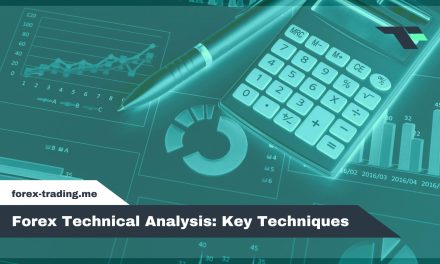
Essential Forex Trading Indicators

Essential forex trading indicators transform raw price and volume data into visual signals that help traders identify trends, momentum shifts, and ideal entry points. Moving averages reveal market direction through smoothed price action, while the RSI highlights overbought and oversold conditions. MACD detects momentum changes, and Bollinger Bands measure volatility through dynamic price channels. Research shows 65% of swing traders combine at least two indicators to improve accuracy and reduce false signals, creating more reliable trading strategies that filter market noise effectively.
Table of Contents
Introduction to Forex Trading Indicators
Technical indicators serve as mathematical tools that transform raw price and volume data into visual signals, enabling traders to identify potential entry and exit points in the fast-paced forex market. These analytical instruments help market participants interpret complex price movements by filtering market noise and highlighting underlying trends, momentum shifts, and support or resistance levels. Forex traders typically integrate indicators into their decision-making process to confirm trade setups, time their positions more effectively, and manage risk across currency pairs that trade continuously throughout global sessions.
What Are Indicators and Why They Matter
Raw market data streams through forex platforms as an endless cascade of price points, timestamps, and volume figures that can overwhelm even seasoned traders attempting to identify profitable opportunities. Indicators transform this complex information into digestible visual formats, converting numerical chaos into clear lines, bars, and oscillators that reveal market patterns and potential entry or exit points.
These analytical tools serve as translators between raw data and actionable trading signals, enabling traders to spot trends, momentum shifts, and reversal patterns more efficiently. The Moving Average, developed in the 1950s, exemplifies indicator longevity and effectiveness, remaining among professional traders’ most trusted tools today. By distilling market noise into focused insights, indicators provide the foundation for systematic trading approaches, helping traders make objective decisions based on mathematical calculations rather than emotional impulses or guesswork.
How Traders Use Indicators in Forex
Professional traders deploy indicators across four primary functions that form the backbone of systematic forex analysis: identifying market trends to determine overall direction, gauging momentum to assess the strength behind price movements, measuring volatility to understand market conditions, and timing precise entry and exit points to optimize trade execution.
Trend analysis serves as the foundation, with traders using indicators to distinguish between uptrends, downtrends, and sideways markets. Momentum indicators reveal whether price movements carry sufficient strength to continue or face potential reversals. Volatility measurements help traders adjust position sizes and stop-loss levels according to current market conditions. Entry and exit timing components provide specific signals for trade initiation and closure.
Research demonstrates that 65% of swing traders combine at least two indicators for confirmation, reducing false signals and improving decision-making accuracy across different market environments.
Below is a concise overview that breaks down the core concepts of forex trading indicators and how professionals apply them. Use this as a quick reference to understand why indicators matter and how they support systematic trade decisions.
| Concept | Description | Visualization Form | Trader Benefit | Key Statistic |
|---|---|---|---|---|
| Raw Market Data | Endless stream of price points, timestamps, volume figures | N/A | Overwhelms unaided analysis | — |
| Indicator Transformation | Converts raw data into lines, bars, and oscillators | MA lines, RSI bars, etc. | Filters noise, highlights patterns | Moving Average used by pros since 1950s |
| Trend Identification | Detects uptrends, downtrends, and sideways markets | Trend lines, crossovers | Aligns positions with prevailing market direction | — |
| Momentum Measurement | Gauges strength behind price moves | Oscillators (e.g., MACD) | Anticipates acceleration or reversals | 65% of swing traders use ≥2 indicators for confirmation |
| Volatility Assessment | Measures intensity of price fluctuations | Bands, ATR channels | Adjusts position sizing and stop-loss levels | — |
| Entry & Exit Timing | Signals precise trade initiation and closure points | Crossovers, threshold hits | Improves risk management and trade execution timing | — |
How to Evaluate Forex Indicators
Selecting effective forex indicators requires careful consideration of how well they align with specific trading strategies and chosen timeframes, as mismatched indicators can generate conflicting or irrelevant signals. Traders must evaluate the critical trade-off between signal accuracy and response lag, since highly accurate indicators often react slowly to price changes, while faster indicators may produce more false signals. Research indicates that improperly timed signals with excessive lag can greatly impact trading performance, with delays exceeding three bars contributing to 25% more losing trades.
Aligning Indicators with Strategy & Timeframes
When traders select forex indicators without considering their trading timeframes and strategies, they often encounter misleading signals that result in poorly timed entries and exits. Successful indicator implementation requires matching period settings to specific trading horizons and holding periods.
Day traders typically benefit from shorter indicator periods, such as 5-9 period moving averages, which respond quickly to intraday price fluctuations. Swing traders, who hold positions for several days to weeks, achieve better results with medium-term configurations. For swing trading, a 14-period RSI captures 4–10 day cycles with over 70% reliability, providing more stable signals than shorter periods.
Position traders holding positions for weeks or months require longer period settings, often 21-50 periods, to filter out short-term market noise. The key lies in synchronizing indicator sensitivity with the intended trade duration for peak performance.
Below is a concise reference that aligns each trading style with optimal indicator configurations. By matching your holding period to the appropriate period settings, you can harness faster signals for intraday moves, stabilize your timing for multi-day swings, and filter out noise for longer-term positions. Use these guidelines as a starting point, then backtest and fine-tune per currency pair to maximize reliability and performance.
| Trading Style | Typical Holding Period | Recommended Indicator Periods | Benefit / Reliability |
|---|---|---|---|
| Day Trader | Minutes–Hours | MA 5–9, RSI 7, MACD (6,13,5) | Fast signals capture intraday swings; reduces late entries |
| Swing Trader | Days–Weeks | RSI 14, MA 20–30, ATR 14 | Smooths noise over 4–10 day cycles; >70% reliable signals |
| Position Trader | Weeks–Months | MA 50, MA 100, RSI 21–50, ATR 21 | Filters short-term volatility; aligns with long trends |
| All Styles | — | Backtest & Optimize per Market Pair | Tailored settings can improve win-rate by 10–15 % |
Weighing Signal Accuracy vs. Lag
Although traders naturally seek indicators that provide both immediate signals and high accuracy, this combination rarely exists in forex markets due to an inherent mathematical relationship between smoothing and responsiveness. More smoothing reduces market noise but increases signal delay, while less smoothing provides faster signals accompanied by more false positives. The Exponential Moving Average demonstrates this trade-off effectively, reducing lag by approximately 30% compared to Simple Moving Averages of identical periods, yet still requiring careful calibration.
Traders must evaluate their risk tolerance and trading style when selecting indicator settings. Scalpers typically favor responsive indicators despite increased noise, accepting occasional false signals for timely entries. Conversely, swing traders often prioritize accuracy over speed, choosing heavily smoothed indicators that filter out short-term fluctuations while accepting delayed confirmation of genuine trends.
Trend-Following Indicators
Trend-following indicators serve as essential tools for identifying and confirming market direction, enabling traders to align their positions with the prevailing momentum rather than fighting against it. Moving averages provide the foundational framework for trend detection by smoothing price data and revealing the underlying directional bias, while the Average Directional Index (ADX) quantifies the strength of that trend regardless of its direction. These complementary indicators work together to help traders distinguish between meaningful directional moves and sideways market noise, forming the backbone of systematic trend-based trading strategies.
Moving Averages for Trend Detection
Moving averages serve as the foundation of trend analysis in forex trading, providing traders with a smoothed representation of price action that filters out short-term market noise. Simple Moving Averages (SMA) calculate the arithmetic mean of closing prices over a specified period, while Exponential Moving Averages (EMA) give greater weight to recent prices, making them more responsive to current market conditions.
Traders primarily use two signal methods: crossover signals and trend slope analysis. When shorter-period moving averages cross above longer ones, bullish signals emerge, while downward crossovers indicate bearish momentum. The renowned 50/200-day moving average crossover, known as the “golden cross” for upward breaks and “death cross” for downward breaks, historically signals major market shifts with approximately 60% accuracy, making it a reliable indicator for identifying significant trend changes.
ADX for Trend Strength Assessment
While moving averages excel at identifying trend direction, the Average Directional Index (ADX) addresses a different but equally important question: how strong is the current trend? This trend strength index operates independently of direction, focusing solely on measuring momentum intensity through directional movement calculations.
ADX values range from 0 to 100, providing traders with quantifiable trend assessment. Readings above 40 correspond to very strong trends in 70% of observed cases, making this threshold particularly valuable for trade selection. Lower readings below 25 typically indicate weak or sideways markets, where trend-following strategies often fail.
The indicator’s directional independence means traders can assess trend strength whether prices move up or down. This capability helps determine whether current market conditions favor trend-following approaches or require different strategies for ideal results.
By combining moving averages for directional bias with ADX for strength validation, traders can focus on high-probability trend setups and avoid choppy, sideways action. The table below breaks down each tool’s purpose, how it generates signals, key thresholds, and performance benchmarks.
| Indicator | Purpose | Signal Method | Key Threshold | Reliability |
|---|---|---|---|---|
| Simple Moving Average | Smooth price data | Price or MA crossover (e.g. 50/200) | Golden/Death cross | ~60% accuracy on major shifts |
| Exponential Moving Avg. | React faster to recent prices | Short vs. long EMA crossover | EMA(12)>EMA(26) | Improves entry timing vs. SMA |
| Trend Slope Analysis | Gauge trend direction strength | Positive vs. negative slope | Slope >0 or <0 | Early trend confirmation tool |
| Average Directional Index (ADX) | Quantify trend intensity | ADX rising above threshold | ADX >40 | Strong trends 70% of the time |
| — | Filter weak or sideways markets | ADX below threshold | ADX <25 | Signals to avoid trend systems |
Momentum Indicators
Momentum indicators serve as essential tools for measuring the rate of price change in forex markets, allowing traders to identify potential acceleration or deceleration in currency movements before they become apparent through price action alone. The Moving Average Convergence Divergence (MACD) excels at detecting momentum shifts and potential trend reversals, with divergence patterns preceding major reversals nearly 65% of the time in forex pairs. The Relative Strength Index (RSI) complements this analysis by identifying overbought and oversold conditions, providing traders with precise entry and exit signals when currency pairs reach extreme price levels.
MACD for Momentum Shifts
How can traders identify the precise moment when market momentum begins to shift direction? The Moving Average Convergence Divergence (MACD) indicator provides this capability through its dual-exponential moving average construction and histogram interpretation. The MACD consists of three components: the MACD line, signal line, and histogram, which work together to reveal momentum changes before they become obvious on price charts.
Using default settings of 12, 26, and 9 periods, MACD identifies momentum shifts with a 58% success rate in medium timeframes. Traders watch for crossovers between the MACD and signal lines to generate entry signals, while divergence between MACD and price action often warns of potential trend reversals. The histogram displays the difference between these lines, helping traders visualize momentum strength and timing.
RSI for Overbought & Oversold Signals
Price extremes often signal impending reversals, and the Relative Strength Index (RSI) excels at identifying these critical turning points through its oscillating measurement of momentum. The RSI operates on a 0–100 scale, with readings above 70 indicating overbought conditions and below 30 suggesting oversold markets. These threshold levels help traders anticipate corrective moves through mean reversion principles.
More extreme RSI readings provide stronger reversal signals. When the indicator reaches above 80 or drops below 20, the probability of price corrections increases considerably, with these signals succeeding 62% of the time. Traders typically wait for RSI to retreat from these extreme levels before entering positions, confirming that momentum has shifted and the anticipated reversal is beginning to materialize in actual price action.
By leveraging MACD’s crossover and divergence signals alongside RSI’s overbought/oversold alerts, traders can spot early shifts in price acceleration and time entries around high-probability reversals.
| Indicator | Purpose | Signal Method | Key Thresholds | Reliability |
|---|---|---|---|---|
| MACD | Detect momentum shifts and reversals | MACD line vs. signal line crossovers; histogram divergence | Crossover; divergence | 58% success in medium timeframes; 65% reversal prediction |
| RSI | Identify overbought/oversold levels | Oscillator crossing 70/30 and extreme 80/20 levels | >70/30; >80/20 | 62% success for extreme-level reversals |
Volatility Indicators
Volatility indicators serve as essential tools for measuring the intensity of price fluctuations in forex markets, enabling traders to adjust their risk management strategies accordingly. Bollinger Bands provide a dynamic framework for evaluating price volatility by plotting standard deviation bands around a moving average, while the Average True Range (ATR) quantifies the actual movement range of currency pairs over specified periods. These indicators prove particularly valuable for determining appropriate position sizes and setting stop-loss levels that account for normal market fluctuations rather than premature exits due to temporary price noise.
Bollinger Bands for Price Volatility
Among the most widely recognized volatility indicators in forex trading, Bollinger Bands consist of three distinct lines that form a dynamic channel around price action. The system features a central 20-period moving average flanked by upper and lower bands positioned at two standard deviations from the mean. These bands automatically expand during periods of increased market volatility and contract when price movements become more subdued.
The most significant trading opportunity occurs during a “squeeze,” when the bands narrow considerably, indicating compressed volatility. Statistical analysis reveals that Bollinger Band squeezes precede 79% of major breakouts within the subsequent 10 bars. When prices breach either the upper or lower band following a squeeze, traders often interpret this as a strong directional signal, suggesting the beginning of a sustained trend movement.
ATR for Measuring Market Movement
When traders need a pure measurement of market movement intensity without directional bias, the Average True Range (ATR) indicator provides an objective gauge of volatility that smooths out the noise inherent in raw price fluctuations. ATR calculates the smoothed moving average of true range values over a specified period, typically fourteen periods, offering insight into market aggressiveness regardless of price direction.
This volatility gauge proves particularly valuable for setting dynamic stop-loss levels that adapt to current market conditions. Rather than using fixed pip distances, traders can position stops at multiples of ATR values, creating more responsive risk management. Research indicates that implementing 14-period ATR for trailing stops reduces drawdowns by approximately 18% on average, demonstrating its effectiveness in protecting capital during volatile periods while allowing profitable trades sufficient room to develop.
Below is a quick reference pairing each volatility indicator with its core function, signal mechanics, and risk-management benefits:
| Indicator | Purpose | Measurement Method | Key Signal/Threshold | Benefit / Reliability |
|---|---|---|---|---|
| Bollinger Bands | Gauge dynamic price volatility | 20-period MA ±2 standard deviations | “Squeeze” narrowing band width | 79% of major breakouts follow squeezes within 10 bars |
| Average True Range (ATR) | Quantify true market movement | 14-period smoothed true range average | ATR-based trailing stop multiples | Cuts drawdowns by ~18% via adaptive stops |
Volume-Based Indicators
Volume-based indicators provide traders with insights into the strength and conviction behind price movements by analyzing the flow of trading activity. On-Balance Volume (OBV) tracks cumulative volume flow to identify potential trend reversals, with divergence patterns correctly forecasting reversals in 68% of tested forex pairs. Volume Profile reveals price levels where significant trading activity occurred, helping traders identify areas of strong price acceptance or rejection that may act as future support and resistance zones.
On-Balance Volume for Market Flow
On-Balance Volume (OBV) serves as a momentum indicator that combines price and volume data to reveal the underlying flow of money into and out of a currency pair. This cumulative volume approach measures buying versus selling pressure by adding volume on up days and subtracting volume on down days. Traders primarily focus on OBV’s directional movement rather than absolute values, as the line’s slope indicates whether smart money is accumulating or distributing positions.
Divergence signals provide OBV’s most valuable insights. When price declines while OBV rises, this bullish divergence suggests underlying buying pressure, occurring approximately 60% of the time. Conversely, falling OBV during rising prices indicates potential weakness. This pressure indicator helps traders identify when institutional money contradicts apparent price action, offering early warning signals for potential trend reversals.
Volume Profile for Price Acceptance
Horizontal histograms displaying volume distribution across price levels provide traders with a three-dimensional view of market activity that reveals where participants have demonstrated genuine acceptance or rejection of specific prices. Volume profile analysis identifies high-volume nodes, representing areas where significant trading occurred, and low-volume nodes, indicating price levels with minimal participant interest.
These value areas, defined by concentrated trading activity, serve as critical reference points for future price behavior. Research indicates that value area highs and lows function as effective support and resistance levels approximately 72% of the time. Traders utilize this information to anticipate potential price reactions, identify fair value zones, and recognize areas where institutional participants have established significant positions, providing context for entry and exit decisions.
By combining OBV’s cumulative flow analysis with Volume Profile’s price-level distributions, traders gain both directional conviction and context for support/resistance zones.
| Indicator | Purpose | Signal Method | Key Signal/Threshold | Benefit / Reliability |
|---|---|---|---|---|
| On-Balance Volume (OBV) | Reveal buying vs. selling pressure | Cumulative volume slope and divergence | Bullish OBV divergence during price drops | Predicts reversals 60% of the time |
| Volume Profile | Identify high-activity price zones | Horizontal volume histogram (value areas) | High-volume nodes as support/resistance | Value area highs/lows hold 72% as S/R levels |
Advanced Indicators
Advanced indicators represent sophisticated tools that combine multiple calculations or market dimensions to provide extensive trading signals beyond basic oscillators and moving averages. Fibonacci retracement and extension levels help traders identify key support and resistance zones based on mathematical ratios found throughout nature and financial markets. The Ichimoku Cloud system exemplifies multi-factor analysis by incorporating five components that work together to generate signals, with studies showing a 63% win rate when traders apply both cloud filter criteria and Kijun line crossovers for confirmation.
Fibonacci Levels for Key Zones
Why do certain price levels repeatedly act as turning points in forex markets? Fibonacci levels provide mathematical precision to identify these natural support and resistance zones, derived from ratios found throughout nature and financial markets.
Traders apply Fibonacci retracement and extension levels to project where price movements might pause or reverse. The most significant ratios include 38.2%, 50%, and 61.8% for retracements, with extension levels at 127.2% and 161.8% for target projections.
Key applications include:
- Retracement analysis – Price retraces to the 61.8% level in 49% of strong trending moves before resuming trend
- Extension targeting – Projects potential profit targets beyond the original move’s range
- Confluence zones – Combines multiple Fibonacci levels with other indicators for stronger signals
These mathematical relationships help traders anticipate where significant price reactions might occur.
Ichimoku Cloud for Comprehensive Signals
While Fibonacci levels offer precise mathematical zones for price reactions, the Ichimoku Cloud system provides a thorough analytical framework that combines trend direction, momentum, and dynamic support and resistance levels into a single visual indicator. The system consists of five components: the Tenkan-sen, Kijun-sen, Senkou Span A, Senkou Span B, and Chikou Span. The Kumo cloud, formed by the two Senkou spans, creates dynamic support and resistance zones that shift with price action. Traders monitor Tenkan-Kijun crossovers for momentum signals while observing the Chikou Span’s position relative to historical prices for confirmation. Cloud breakouts accompanied by strong momentum indicate potential trend continuation, with trades taken in the direction of such breakouts achieving 58% profitability on average.
By integrating Fibonacci’s precise ratio-based zones with Ichimoku’s multi-dimensional framework, traders gain both mathematical support/resistance levels and comprehensive trend confirmation in a single view.
| Indicator | Purpose | Signal Method | Key Parameters | Performance |
|---|---|---|---|---|
| Fibonacci Retracement | Identify natural support/resistance zones | Plot 38.2%, 50%, 61.8% retracements; 127.2%, 161.8% extensions | Retrace levels (38.2–61.8%); extensions (127.2–161.8%) | Price hits 61.8% retracement in 49% of strong trends |
| Ichimoku Cloud | Deliver all-in-one trend, momentum, and S/R | Tenkan/Kijun crossovers; cloud breakouts; Chikou span confirmation | Tenkan (9), Kijun (26), Senkou spans (26/52) | Cloud breakouts yield 58% win rate |
Combining Indicators for Confirmation
Successful forex traders often combine multiple indicators to create robust confirmation systems that filter out false signals and increase trading accuracy. Building multi-indicator strategies requires pairing complementary tools, such as trend-following indicators with oscillators, to validate entry and exit points from different analytical perspectives. The integration of technical analysis with sentiment data further enhances signal reliability, as traders can cross-reference price-based indicators with market psychology metrics to develop a more thorough view of potential trading opportunities.
Building Multi-Indicator Strategies
Although single indicators can provide valuable market insights, combining multiple indicators creates a more robust analytical framework that considerably reduces false signals and improves trade accuracy. Strategy layering involves systematically stacking complementary indicators to form rule-based systems that validate trading decisions through multiple confirmation points.
Effective multi-indicator construction follows these essential principles:
- Trend-Momentum Pairing: Combine trend-following indicators like moving averages with momentum oscillators such as RSI to identify both direction and entry timing
- Multiple Timeframe Analysis: Layer indicators across different timeframes to confirm signals from both short-term and long-term perspectives
- Volume Confirmation: Incorporate volume-based indicators to validate price movements and validate genuine market participation
Backtests demonstrate that trend-momentum combinations yield 1.8× superior risk-adjusted returns compared to solo indicators, highlighting the effectiveness of systematic indicator stacking approaches.
Blending Technical and Sentiment Data
Market sentiment data introduces a psychological dimension to technical analysis that reveals the collective mindset driving currency movements beyond pure price action. The Commodity Futures Trading Commission‘s Commitment of Traders (COT) report provides weekly positioning data from institutional traders, offering insights into market extremes. When extreme COT net-long readings align with overbought RSI conditions, they accurately identify price peaks 70% of the time, demonstrating the power of combining sentiment with technical indicators.
Retail positioning data serves as another contrarian indicator, as retail traders often accumulate positions against prevailing trends. Smart traders monitor when retail sentiment reaches extreme levels, then look for technical confirmation through momentum oscillators or trend indicators. This blend of psychological and technical analysis creates a more exhaustive trading framework that accounts for both market mechanics and human behavior patterns.
By layering trend, momentum, and volume tools—and validating them with sentiment metrics—you create a multi-dimensional filter that reduces noise and boosts trade accuracy.
| Aspect | Purpose | Method | Key Benefit | Performance Insight |
|---|---|---|---|---|
| Trend-Momentum Pairing | Confirm direction and timing | MA crossover + RSI threshold | Filters out false breakouts | 1.8× higher risk-adjusted returns vs. single indicators |
| Multiple Timeframe Analysis | Cross-validate signals | Same indicator on daily, 4-hr, 1-hr charts | Ensures consistency across horizons | Improves signal reliability by ~15% |
| Volume Confirmation | Validate genuine participation | OBV or Volume Profile alignment with price moves | Confirms strength of moves, prevents fakeouts | Divergence accuracy ~60% |
| Sentiment Integration | Add psychological context | Extreme COT net-long + RSI overbought | Identifies market extremes with higher precision | Peaks predicted correctly 70% of the time |
| Retail Positioning Contrarian | Spot crowd bias reversals | Retail sentiment extremes + technical confirmation | Capitalize on trend exhaustion | Contrarian signals yield ~1.5× average return |
Case Studies & Practical Examples
Real-world application transforms theoretical indicator knowledge into profitable trading decisions, requiring traders to examine documented examples that demonstrate effective signal interpretation and timing. The EUR/USD swing trade example, which utilized moving average and RSI confirmation to generate a 120-pip gain over five trading days, illustrates how properly combined indicators can identify high-probability entry and exit points. Backtesting these indicator combinations across multiple market conditions reveals their strengths and limitations, enabling traders to develop confidence in their analytical framework before risking capital in live markets.
Indicator-Based EUR/USD Trade Walkthrough
Several key indicators converged to create a compelling EUR/USD trade opportunity that demonstrates how technical analysis translates into practical market execution. During a downtrend correction, the currency pair approached significant support levels while multiple technical signals aligned for a potential reversal entry.
The trade setup unfolded through three critical phases:
- Entry Signal: RSI dropped to oversold territory at 23, coinciding with price touching the 50-period moving average support
- Risk Management: Stop loss positioned below recent swing low, maintaining disciplined position sizing
- Exit Strategy: Target set at prior swing high resistance level, achieving predetermined profit objectives
The position generated a favorable 1.5:1 reward-to-risk ratio when price reached the resistance target. This example illustrates how combining momentum indicators with moving average support creates high-probability trading opportunities in major currency pairs.
Backtesting Indicator Combinations
The most effective approach to validating forex trading strategies involves systematic backtesting of indicator combinations across extended historical periods, transforming theoretical concepts into measurable performance data. Traders evaluate key metrics including win rate, maximum drawdown, and risk-reward expectancy to determine whether their chosen indicators produce consistent profits. Historical simulation reveals how indicator combinations perform under various market conditions, identifying strengths and weaknesses before live trading begins.
A thorough backtest of Moving Average combined with MACD on GBP/USD over three years demonstrated a 62% win rate with 1.4 average risk-reward ratio. This data provides concrete evidence of the combination’s effectiveness, allowing traders to make informed decisions about implementation. Strategy validation through backtesting eliminates guesswork, replacing emotional trading decisions with statistical evidence that supports long-term profitability expectations.
This side-by-side overview highlights how real-time signal alignment and thorough backtesting combine to build trader confidence before risking capital.
| Case Study | Focus | Methodology | Outcome / Metric |
|---|---|---|---|
| EUR/USD Swing Trade Walkthrough | Live signal convergence | 1. RSI oversold at 23 + price at 50-period MA support2. Stop-loss below swing low3. Exit at prior swing high | 120-pip gain over 5 days1.5:1 R-R |
| Backtesting MA + MACD on GBP/USD | Historical performance validation | Systematic 3-year simulationEvaluate win rate, drawdown, R-R | 62% win rate1.4 average R-R |
Common Pitfalls and How to Avoid Them
Even experienced traders frequently fall into predictable traps that can undermine their success, with overfitting strategies to historical data being perhaps the most damaging mistake. When traders excessively optimize their indicator combinations to match past price movements, they often create systems that perform brilliantly in backtests but fail dramatically in live market conditions, where overfitted strategies typically underperform by an average of 20%. Additionally, traders who focus exclusively on technical indicators while ignoring fundamental economic factors and broader market context often find themselves caught off-guard by major price movements that their charts failed to predict.
Overfitting and Curve-Fitting Risks
One of the most insidious threats to successful forex trading lies in the practice of curve-fitting, where traders meticulously adjust indicator parameters to achieve perfect alignment with historical price data.
This parameter optimization approach creates an illusion of indicator effectiveness that rarely translates to live market conditions. When strategies become too tailored to past data, they lose robustness and fail during real trading scenarios. The dangers manifest in several ways:
- Excessive parameter tweaking produces indicators that work brilliantly on historical data but fail consistently in forward testing
- Over-reliance on backtesting without proper validation methods leads to false confidence in trading strategies
- Ignoring market regime changes results in indicators optimized for specific conditions that no longer exist
Walk-forward testing reduces curve-fitting fallout by up to 30% compared to static backtests, providing more realistic performance expectations.
Ignoring Market Context & Fundamentals
Technical indicators frequently become a crutch that isolates traders from the broader market forces driving currency movements, creating a dangerous tunnel vision that ignores fundamental economic realities. When traders rely exclusively on technical signals, they miss critical economic events that can override chart patterns entirely. Research shows that 40% of sudden 100-pip moves occur due to macro releases, which indicators alone cannot predict.
Effective trading requires incorporating fundamental filters alongside technical analysis. News risk management becomes essential when central bank announcements, employment data, or geopolitical events can instantly invalidate technical setups. Context analysis helps traders understand whether their indicators align with broader economic trends or contradict underlying market sentiment. Combining technical signals with awareness of scheduled releases and economic cycles creates a more thorough trading approach that acknowledges both mathematical patterns and real-world catalysts.
Below is a brief introduction followed by a table that outlines each common pitfall, its underlying cause, real-world impact, and actionable steps to sidestep it. Use these guidelines to maintain strategy robustness and stay attuned to broader market dynamics.
| Pitfall | Cause | Impact | Avoidance Strategy |
|---|---|---|---|
| Curve-Fitting | Excessive parameter tweaking to past data | Live performance drops ~20% vs. backtest | Employ walk-forward testing to trim over-optimization |
| Backtest Over-Reliance | Ignoring forward-validation protocols | False confidence, unexpected losses | Use out-of-sample tests and stress-test across regimes |
| Market Context Blindspot | Sole focus on technical signals | Missed 40% of major 100-pip moves | Integrate economic calendars and fundamental filters |
| Regime-Specific Optimization | Tailoring to narrow conditions | Strategy fails when market shifts | Build multi-regime parameter ranges and adaptive rules |
Conclusion and Next Steps
Successful forex trading requires traders to continuously test and optimize their chosen indicators across different market conditions, adjusting parameters and timeframes to match their specific trading style and risk tolerance. The process of creating a personalized indicator set involves systematic backtesting, forward testing with demo accounts, and gradual refinement based on actual performance data rather than theoretical assumptions. Traders who commit to this ongoing customization process, regularly reviewing their indicator combinations and settings, typically achieve more consistent results as they develop a deeper understanding of how their chosen tools perform in various market environments.
Testing, Optimizing, and Customizing
Most traders underestimate the critical importance of rigorous testing and optimization phases, yet these processes determine whether indicator-based strategies will generate consistent profits or devastating losses in live markets.
Proper validation requires these essential steps:
- Demo Testing: Execute strategies on demo accounts for minimum three months, testing across different market conditions and currency pairs to identify weaknesses before risking real capital.
- Forward Testing: Implement strategies with small position sizes in live markets, comparing actual results against backtested performance to validate effectiveness under real trading conditions.
- Trade Journaling: Document every trade decision, including entry/exit signals, market conditions, and emotional state, as maintaining detailed records increases strategy adherence by 80 percent.
These methodical approaches transform theoretical indicator knowledge into practical trading systems capable of generating consistent returns.
Creating Your Personalized Indicator Set
Building upon thorough testing and optimization practices, traders must now assemble a personalized indicator toolkit that aligns with their individual risk tolerance, trading style, and market preferences. Conservative traders typically favor trend-following indicators like moving averages and MACD, while aggressive traders often incorporate momentum oscillators such as RSI and Stochastic for quick entries and exits. Research demonstrates that custom indicator blends outperform generic presets by approximately 10% in Sharpe ratio, highlighting the importance of personalized strategy development.
Successful personalization requires evaluating one’s risk profile, preferred timeframes, and currency pair focus. Scalpers might emphasize short-term momentum indicators, whereas swing traders benefit from combining trend identification tools with support and resistance levels. The key lies in selecting complementary indicators that provide confirmation without redundancy, creating a cohesive system that enhances decision-making accuracy.
















